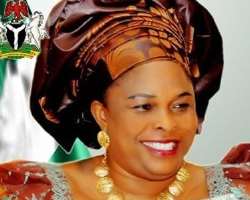Thinking Peace With The Children

By Isiaka Aliagan
These past months, we have all lived in fear. Although respite is within sight, with the declaration of state of emergency in three volatile states of the north, we cannot all forget in a hurry the deluge of violence that has claimed many lives and led to wanton destruction of property in our nation.
While the madness subsisted, very few considered what danger these orgies of violence portend for our children. We also did not consider that some innocent souls might be getting poisoned by the din of hate that has become the mantra of some, while the nation bled and nursed its festering wounds.
No doubt, after the war on terror is eventually won, we would return to peace, to healing and to reconciliation. But the healing process need not wait till then. We must begin now to work on our children who have been spectators in the macabre dance that we have witnessed all this while.
This was what the First Lady, Dame (Dr.) Patience Goodluck Jonathan strove to do in the evening of May 27, while she hosted the 2013 children day party. It was a solemn occasion to dream peace, think peace and sow peace in the minds of the children; for the child is the future of the nation.
It is clear to all that as our children grow under this inclement and violent times, it is important that we teach them, to let them know and to make them begin to appreciate that there is no alternative to peace for us a nation. We should begin to involve them in the quest for a better tomorrow, through peace building.
'We love peace.' That was the central message of the First Lady to the cream of Nigerian children that attended the children day funfair at the presidential villa. This message was packaged in a child-friendly rhymed booklet of similar title with beautiful illustrations.
The book is a striking collection of 29 pages of short rhythmical phrases and sentences that are memorable. It was produced by the First Lady for Nigerian children to enable them appreciate the value of peace and how this could enhance the development of the nation.
The booklet can be divided into two main themes: what peace is and what peace could achieve. The first 22 pages define what peace is while the last seven pages illustrate the value of peace and what positive developments it could bring to the society.
It begins by affirming 'we love peace,' then going into the various shades and dimensions of peace such as 'loving my neighbour as myself,' 'making new friends,' 'making others happy,' 'saying I am sorry when I hurt someone,' 'keeping my environment safe and clean,' 'to forgive,' 'respecting others' religious beliefs,' 'being kind,' 'helping someone in need,' 'sharing,' 'not taking what belongs to others without their permission,' 'obeying the law,' 'staying away from anything that can hurt me and others,' 'reporting to the Police whenever I see anyone doing what I know would hurt others,' 'saying no to violence,' 'not bullying others,' 'to think peaceful thoughts,' and 'praying for peace.'
These are short memorable phrases that demonstrate the concept of peace. When interpreted the other way, it means not heeding these messages causes the opposite of peace, which is violence and insecurity.
Thus, when we love ourselves more than others, when we like making others unhappy, refuse to apologize or own up to our mistakes when we are wrong or have hurt someone, keeping malice rather than forgive, intolerant of others' religious beliefs, being unkind to people, breaking the law, concealing crime and criminals, taking what does not belong to us, encouraging and abetting violence, among others, we are stoking violence and insecurity.
In essence, the regime of violence that has been recorded in some parts of the country is due to the action or inaction of some people in relation to making peace.
What do we have to gain when there is peace in the nation? That is the second part of the thematic concern of the booklet. Thus, when there is peace 'our leaders can work to develop our country,' 'children can work and play, 'children can go to school,' and 'children are assured of brighter future.'
At some point, when we decide to count our losses as a result of the violence that has rocked some parts of our nation, we will realize that violence does not pay. We would realize that violence is distracting our leaders from tackling development challenges.
If like the children read and sang during the May 27 event, we can chant this refrain to ourselves everyday as a solemn mantra, 'I love peace, I seek peace, I am for peace, I am an instrument of peace,' we can then begin to 'imagine peace, think peace, and talk peace,' and eventually 'make peace.' It is as simple as that.
The First Lady has shown the way; the alternative route out of the regime of fear that has held many to ransom. Let us begin to think and act peace now.
Dr. isiaka Aliagan is of the Office of the First Lady, Federal Republic of Nigeria
